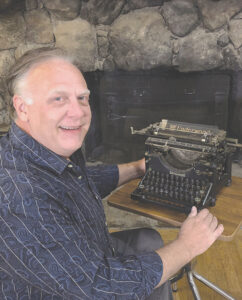Music Man of the Seven Hills
Words escalated until blows were exchanged. Both got in their licks, but I believe it was James who came out on top.
This was the beginning of the end of the business relationship between James T. Fitzgerald and Frederick W. Blanchard in spring 1898. In August of that year, James pleaded guilty to Fred’s charge of battery against him and their ties were severed. The two men had purchased Charles Day Music Store less than a decade earlier at 113 S. Spring St., and business had been brisk. Even though now separated, these two men would go on to contribute greatly to the cultural life of Los Angeles.
James Tabor Fitzgerald was born in San Francisco in 1864 to Mary Ann and George Fitzgerald. Since the age of 19, George had spent years at sea as a whaler out of Boston. At 30 he was married and soon headed west, finding work on the docks of San Francisco Bay and staying close to home. The couple would eventually have six children. At 26, James made his way to Los Angeles and soon joined forces with Fred Blanchard.
After the separation, James gained control of the store and Fred moved into the newly constructed Newmark Building and started a competing enterprise. The Fitzgerald Music Company initially sold sheet music and harmonicas but quickly expanded to sell other instruments and pianos. In one ad it claimed to be the largest Victrola dealer in the west.
There is more than one connection that can be made between the Crescenta Valley and this successful downtown merchant. For starters, on page 150 of the book “La Crescenta: Sources of History,” compiled by June Dougherty, we find a photo labeled Early Dwelling. It shows a small stone home, perhaps the first built in the valley by the Begue Family in 1882. They had homesteaded the land surrounding Tujunga Canyon Boulevard as it descends to the 210 Freeway from Foothill. The picture was taken about 1906. Sitting out front of the little cabin is James Fitzgerald and his mother Mary Ann. When the photo was published in 1973 the home was owned by Charleston Dow, a nephew of James.
The connection to James T. Fitzgerald that is more well-known is his purchase of Seven Hills, a large neighborhood just north of Tujunga, sometime before 1920. At that time, he had acquired a great deal of wealth from his business endeavors and purchased the 100-plus acres as a home away from home from the early Sunland-Tujunga pioneer Loren Rowley. The Fitzgeralds’ main residence was in the wealthy West Adams district of Los Angeles, found today at 3115 W. Adams Blvd.
In the years following the split with Mr. Blanchard, James and Fred would become active rivals. This competition played well for the citizens of the city. In these early days, it was the music store proprietors who brought in many of the artists and talent for the residents to enjoy. After Fred opened his business, Blanchard Hall, a magazine produced a 32 page special edition devoted to music and art in Southern California. Its society columnist reported that Blanchard and Fitzgerald were the two individuals most responsible for the city’s flourishing concert life, even though they no longer spoke. While it lasted, the competition between the two brought a rich variety of public performances to Los Angeles. A big favorite, under contract with the Fitzgerald Music Company, was the annual appearance of the John Phillip Sousa Band.
James would later lose everything during the Great Depression but was able to re-establish connections and rebuild a business focused on piano sales. The Fitzgerald Music Company was still advertising as late as 1962, the year of its 70th anniversary, but disappeared soon after. The Seven Hills property was purchased by Fred Salter Jr. in 1933 and was subdivided and developed into the neighborhood that can be seen today.
Craig W. Durst, AKA The History Hunter, is a historian of the Tujunga Rancho and president of the Friends of Verdugo Hills Cemetery. He can be reached at craig@thehistoryhunter.com.

